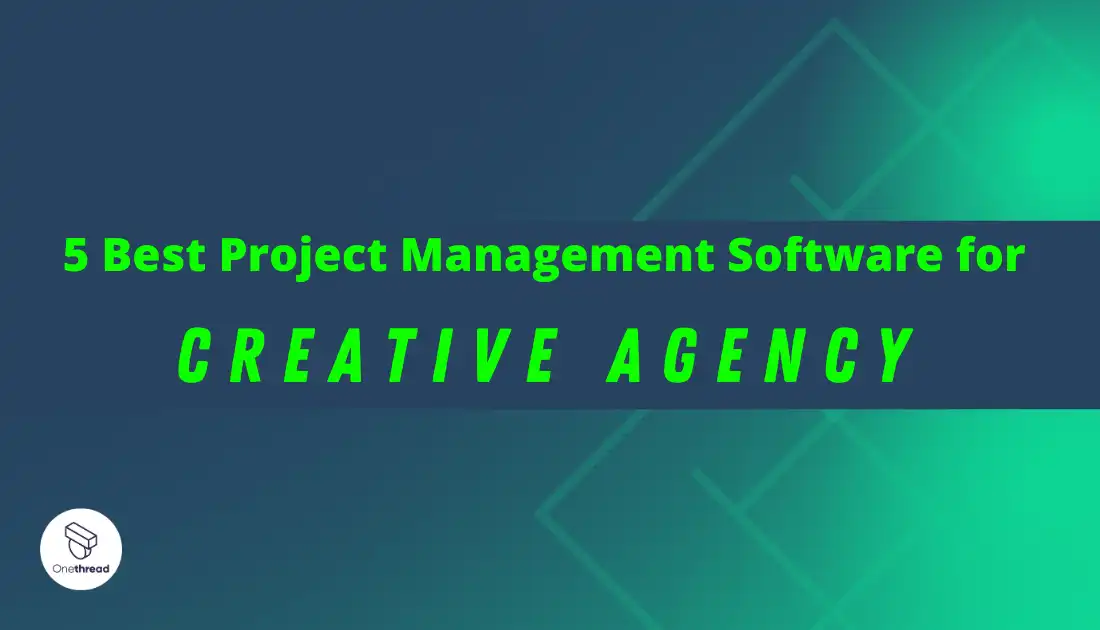According to a recent survey, 63% of creative agencies have their employees work in a combination of on-site and remote. With this hybrid trend of work style, the need for effective project management in creative agencies has never been more apparent.
To address this challenge head-on, we’ve scoured the digital landscape to compile a list of the best project management software solutions tailored specifically for creative agencies.
In this article, we’ll delve into the world of project management, exploring how these tools can streamline workflows, boost collaboration, and ultimately help creative teams transform their visions into reality.
Whether you’re a design studio, marketing agency, or content production house, read on to discover the perfect software to elevate your creative projects to new heights.
Quick List Of 5 Project Management Software For Creative Agency
- Onethread: A versatile platform that helps creative teams plan, track, and manage projects with ease, fostering collaboration and productivity.
- Trello: Known for its visual approach, Trello simplifies project management for creative agencies, allowing teams to organize tasks on customizable boards.
- Monday.com: A highly customizable work operating system that empowers creative agencies to streamline workflows, track progress, and meet project deadlines.
- Wrike: Tailored for creative workflows, Wrike offers features like creative proofing and project planning to enhance collaboration and project execution.
- ClickUp: A comprehensive project management tool that provides creative agencies with task management, time tracking, and document collaboration in one place.
Our reviewers evaluate software independently. Clicks may earn a commission, which supports testing. Learn how we stay transparent & our review methodology
Comparison Chart Of Project Management Software For Creative Agency
| Tool Name | Collaborative Workspace | Creative Workflow Management | Client Collaboration | Time & Resource Management |
| Onethread | Team discussions, Document sharing, comments | Custom Workflow Stages | Client Conversation Threads, vendor management | Time Sheet, Built-in Timer |
| Trello | Shared Boards, Team Cards | Lists & Card Movers | Public & Private Boards | Trello Time Tracking Power-Up |
| Monday.com | Shared Boards, Team Views | Automations & Templates | Shareable Boards, Guest Access | Time Tracking Widget, Workload View |
| Wrike | Shared Folders, Project Spaces | Custom Statuses, Approval Workflows | Guest Access, Client Reports | Time Tracking, Resource Calendars |
| ClickUp | Multiple Views, Shared Docs | Custom Statuses, Dependencies | Guest Permissions, Shared Views | Time Tracking, Resource Allocation |
What is Project Management Software For a Creative Agency?
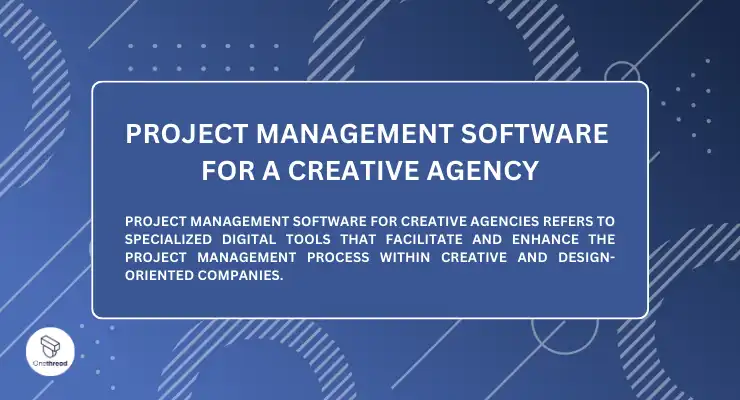
Project Management Software for Creative Agencies refers to specialized digital tools that facilitate and enhance the project management process within creative and design-oriented companies. These software solutions are uniquely tailored to meet the specific needs of creative professionals, such as graphic designers, marketers, content creators, and artists.
They offer features like task assignment, project timelines, collaboration tools, and resource management to help creative teams plan, execute, and track their projects efficiently.
With a focus on visual organization and seamless communication, these tools enable agencies to maintain clarity, meet deadlines, and produce high-quality creative work while managing multiple projects simultaneously.
Project Management Software for Creative Agencies acts as a centralized hub for creative project coordination, promoting productivity and creativity.
Why Project Management Software For Creative Agency Is Important to Your Business?
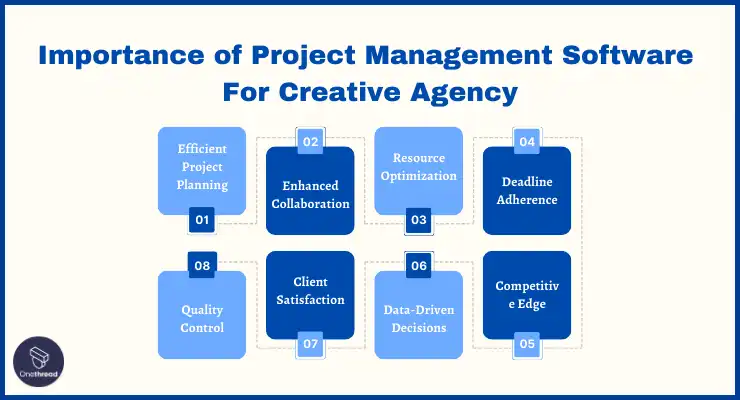
Project Management Software for Creative Agencies is crucial for individuals and businesses in the creative industry for several compelling reasons:
- Efficient Project Planning: It enables meticulous planning, ensuring that projects are well-structured, organized, and adhere to timelines.
- Enhanced Collaboration: Facilitates seamless communication and collaboration among team members, fostering creativity and idea sharing.
- Resource Optimization: Helps in efficient allocation of resources, ensuring that talent and assets are utilized effectively.
- Deadline Adherence: Ensures that deadlines are met consistently, preventing delays and maintaining client satisfaction.
- Quality Control: Promotes quality control by allowing for thorough reviews, revisions, and approvals of creative work.
- Client Satisfaction: Delivers projects on time and within scope, enhancing client relationships and boosting referrals.
- Data-Driven Decisions: Provides valuable insights through data analytics, aiding in informed decision-making and continuous improvement.
- Competitive Edge: Gives creative agencies a competitive advantage by increasing productivity and creativity.
Project Management Software for Creative Agencies is essential for maximizing efficiency, collaboration, and client satisfaction while staying competitive in the creative industry.
Key Features to Consider in Project Management Software For Creative Agency
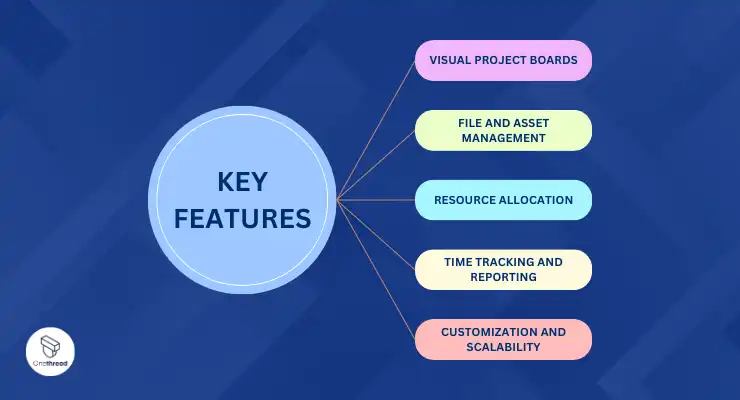
Selecting the right Project Management Software for your Creative Agency is a crucial decision that can significantly impact your workflow and project outcomes. To make an informed choice, it’s essential to understand the key features that cater to the unique needs of creative professionals and teams.
Visual Project Boards:
Visual project boards, often in the form of Kanban boards, offer an intuitive way to organize tasks. They provide a clear, at-a-glance view of project progress, making it easier to identify bottlenecks, allocate resources, and adjust timelines as needed.
File and Asset Management:
Creative projects involve numerous files, from images and videos to design assets. Robust file and asset management capabilities help you store, organize, and access these files easily. Version control ensures that everyone works with the most up-to-date assets.
Resource Allocation:
Managing your team’s resources efficiently is vital. The software should enable you to assign team members to projects, balance workloads, and track availability to prevent burnout and optimize productivity.
Time Tracking and Reporting:
Accurate time tracking ensures that projects stay on budget. The software should offer time-tracking tools for tasks and projects and reporting features that help you analyze project performance and identify areas for improvement.
Customization and Scalability:
Every creative agency is unique. Choose software that allows you to customize workflows, fields, and templates to match your agency’s specific needs. Additionally, consider scalability to accommodate your agency’s growth over time.
Top 5 Project Management Software For Creative Agency
Creativity thrives when it’s organized, and for creative agencies, efficient project management is the compass that guides innovative ideas to reality.
To help creative professionals and teams navigate this landscape effectively, we’ve compiled a list of the top 5 Project Management Software solutions tailor-made for creative agencies.
#1. Onethread
Onethread is a game-changer for creative agencies. It’s a project management software built to meet the unique needs of creative teams.
With Onethread, you can track projects, manage tasks, and collaborate in real-time. It’s more than a to-do list. It integrates seamlessly with design tools and software.
This allows for smooth workflow from concept to completion. With features like time tracking and budget monitoring, it takes the guesswork out of project management. Trust Onethread to keep your creative projects on track and on budget.
Overview and key features
Onethread stands out as a valuable tool in the creative industry. In this comprehensive guide, we’ll explore the key features that make Onethread an exceptional choice for creative agencies, enabling you to transform your projects into success stories.
Visual Project Boards:
Onethread boasts intuitive visual project boards reminiscent of Kanban boards, offering a bird’s-eye view of your project’s progress. This feature simplifies task organization and helps you spot bottlenecks at a glance, allowing for quick adjustments and resource allocation. With Onethread, you also get list view, gantt chart view and calendar view to take this visual management to the new height.
Seamless Collaboration Tools:
Onethread fosters collaboration with real-time chat, commenting, and file-sharing capabilities. Team members, clients, and stakeholders can communicate fluidly, share ideas, and provide feedback, promoting a harmonious creative workflow.
Collaborative Discussions and Feedback.png
Creative Proofing and Feedback:
Creative agencies rely on feedback, and Onethread excels in this area. Its proofing and annotation tools facilitate efficient review processes, reducing misunderstandings and ensuring that creative work aligns with client expectations.
Task & Item Management:
Managing diverse tasks and deadlines is a staple in creative projects. This feature allows you to set priorities, allocate resources, and manage deadlines, ensuring projects are completed on time and within scope.
Insightful Time Tracking and Reporting:
In creative agencies, accurate time tracking is essential for billing and assessing productivity. Onethread’s Timesheet feature enables detailed time logging, aiding in precise invoicing and efficient resource allocation. Besides, Onethread’s robust reporting capabilities can provide valuable information on project timelines, resource utilization, and even profitability.
Pricing plans and options
Here are the pricing plans for the Project Management Software:
- Free Plan:
- Cost: $0
- Basic features with limited storage and support.
- Growth Plan:
- Cost: $3.60/user/month
- Enhanced features, increased storage, and priority support.
- Scale Plan:
- Cost: $6/user/month
- Advanced features, scalable storage, and premium support.
#2. Trello
Trello is a leading project management software tailor-made for creative agencies. Using a visual approach with boards, lists, and cards, Trello makes tracking projects intuitive and engaging. The platform is user-friendly, allowing teams to collaborate in real-time easily.
You can attach files, set deadlines, and assign tasks directly within the app. Trello also offers numerous integrations with other tools, streamlining your agency’s entire workflow.
It’s not just about managing tasks; it’s about bringing your creative vision to life in an organized, efficient manner. With Trello, your creative projects are in good hands.
Trello – Overview
Product Information:
- Company Valuation: $425M
- Employee Numbers:88
Founding Team:
Joel Spolsky & Michael Pryor is the founder of Trello.
Features
Visual Kanban Boards:
Trello’s signature feature is its visual Kanban boards, which are highly intuitive and perfect for creative teams. Each project or task is represented as a card that can be moved through columns representing workflow stages (e.g., to-do, in progress, done). This visual representation helps creative teams to quickly grasp project status and prioritize tasks.
Customizable Workflows:
Trello allows you to customize your workflows with ease. Creative agencies often have diverse project types, from graphic design to content creation. Trello’s flexibility allows you to create unique boards for each project type, tailoring the workflow stages, labels, and cards to match your agency’s specific processes.
Collaborative Features:
Collaboration is essential for creative projects. Trello offers features like comments, file attachments, and mentions, enabling seamless communication among team members. You can also invite clients or external collaborators to specific boards, ensuring transparency and feedback collection.
Trello-Collaboration and Communication.png
Power-Ups and Integrations:
Trello offers a range of Power-Ups (plugins) and integrations with popular creative tools like Adobe Creative Cloud, Slack, and Dropbox. These integrations enhance Trello’s functionality and allow creative agencies to connect their favorite tools directly to their project boards.
Calendar and Due Dates:
For creative agencies, meeting deadlines is crucial. Trello includes a calendar view that provides a clear overview of due dates and project timelines. This feature helps teams manage their schedules effectively and ensures projects stay on track.
Pros & Cons
Pros:
- User-friendly interface
- Strong integrations with other tools
- High degree of customizability
Cons:
- Free version has limited Power-Ups
- May require training for advanced features
- No built-in chat feature
Pricing Plans
- Free: Basic features, limited Power-Ups
- Business Class: $10/month, unlimited Power-Ups, advanced features
- Enterprise: Custom pricing, added security, priority support
Customer Ratings
- G2: 4.3 out of 5 stars
- Capterra: 4.4 out of 5 stars
Review
For our creative agency, Trello has been a valuable project management tool, albeit with some pros and cons. On the plus side, its visual boards and customizable workflows are a creative team’s dream. We love how it facilitates collaboration, with tasks, comments, and attachments all in one place.
However, for larger projects, the lack of in-depth reporting and analytics can be limiting. Also, without proper structure and discipline, Trello boards can become cluttered and overwhelming. Integrations and automation require third-party apps and may not be as seamless as we’d like.
Trello is excellent for visual project management, fostering creativity and collaboration. Yet, it may not meet all the needs of larger creative agencies without additional tools and discipline.
#3. Monday.com
Monday.com is a powerful project management tool perfect for creative agencies. It offers a range of customizable templates and views like Kanban boards, Gantt charts, and timelines.
This flexibility allows creative teams to visualize their workflow in a way that suits them best. Real-time collaboration is a breeze, thanks to features like file sharing, comments, and notifications.
Monday.com also provides robust analytics for tracking time, budgets, and performance metrics. It’s a comprehensive platform designed to manage the complexity of creative projects, ensuring they stay on schedule and meet quality standards.
Monday.com- Overview
Product Information:
- Company Valuation: $7.51 billion as of September 26, 2023.
- Employee Numbers: 1,064 employees.
Founding Team:
Monday.com was founded in 2012 by Roy Mann, Eran Kampf and Eran Zinman
Features
Customizable Workflows:
Creative agencies often have diverse project requirements, from graphic design to content creation. Monday.com allows you to create customized workflows to match each project’s unique process. You can design boards with columns that reflect your agency’s specific stages, making it easy to adapt to various project types.
Monday-Customizable Workflow Templates.png
Visual Project Tracking:
Monday.com’s visual boards provide an intuitive way to track project progress. You can set up boards as Kanban boards, Gantt charts, or timeline views, which are particularly helpful for creative agencies to visualize project timelines, dependencies, and resource allocation.
Monday.com-Visual Project Tracking.png
Collaboration Features:
Monday.com offers a suite of collaboration features, including real-time updates, file sharing, and comments. Team members can easily communicate, share feedback, and attach project assets, streamlining communication within a single platform.
Monday.com-Collaboration and Communication.png
Integration Capabilities:
Creative agencies often rely on various tools for design, content creation, and communication. Monday.com integrates seamlessly with popular creative tools like Adobe Creative Cloud, Slack, and Dropbox. These integrations enhance workflow efficiency and connect your favorite creative apps directly to your project boards.
Pros & Cons
Pros:
- Highly customizable
- Extensive automation capabilities
- Robust time tracking and reporting
Cons:
- A steep learning curve for new users
- Pricier than some alternatives
- Limited features in the free version
Pricing Plans
- Individual: Free, limited features
- Basic: $8/user/month, essential features
- Standard: $10/user/month, added automation and integrations
- Pro: $16/user/month, full suite of advanced features
Customer Ratings
- G2: 4.5 out of 5 stars
- Capterra: 4.6 out of 5 stars
Review
We tried Monday.com at our creative agency. Here’s the scoop. The good: it’s super visual. Even our designers like it. Templates are a lifesaver. Makes project tracking easy. The automation saves time, too.
Now the downsides. It’s pricey. Not great for small teams on a budget. Integration with other tools, like Adobe Creative Suite, could be smoother. Also, the learning curve for advanced features can be a bit steep. You’ll need time to figure it all out.
Bottom line? Monday.com is powerful but comes at a cost. Good for big teams that need robust features. May be overkill for small crews.
#4. Wrike
Wrike is a top-tier project management software ideal for creative agencies. It offers a blend of traditional and agile project management tools, catering to diverse workflows. Wrike features customizable dashboards, real-time updates, and collaboration spaces.
You can track project timelines, assign tasks, and even manage resources right within the platform. Built-in analytics help you keep an eye on budgets and deadlines, critical for any creative project.
Wrike is designed to adapt to your agency’s needs, making it easier to deliver high-quality work on time and within budget.
Wrike – Overview
Product Information:
- Company Valuation: $2.25 billion.
- Employee Numbers: 1,000 employees.
Founding Team:
Wrike was founded in 2006 by Andrew Filev.
Features
1. Dynamic Request Forms
Wrike features dynamic request forms that streamline the intake process. These forms are customizable, allowing you to capture essential project details from the get-go. No more back-and-forths with the client to clarify basic things. You start the project with all the information you need, making for a smoother execution.
2. Interactive Gantt Charts
Timelines matter in project management. Wrike’s interactive Gantt charts give you a visual road map of the project from start to finish. You can easily adjust timelines, set dependencies, and allocate resources. It helps you see the big picture and the finer details, all in one place.
3. Collaborative Workspaces
Wrike offers a real-time collaborative workspace. Team members can edit documents, update statuses, and comment directly on tasks. All project communications stay in one centralized location, making it easier to keep everyone on the same page.
4. Extensive Integrations
If your agency uses other tools, chances are Wrike can integrate with them. Whether it’s Adobe Creative Cloud, Google Workspace, or Slack, Wrike plays well with others. This means less time switching between apps and more time getting work done.
5. Visual Timelines:
Project delays can be costly. With Wrike’s Gantt charts, you see your entire project laid out visually. This makes it easier to identify bottlenecks or overlaps in tasks. You can also adjust timelines with a simple drag-and-drop, keeping the whole team updated on any changes instantly.
Pros & Cons
Pros:
- Highly customizable request forms
- User-friendly Gantt charts for easy planning
- Strong integrations with other industry-standard tools
Cons:
- May be overwhelming for small teams
- Requires time to set up and customize
- Slightly higher learning curve
Pricing Plans
- Free: Up to 5 users, basic features
- Professional: $9.80/user/month, additional planning tools
- Business: $24.80/user/month, full customization and automation
- Enterprise: Custom pricing, advanced security and support
Customer Ratings
- G2: 4.2 out of 5 stars
- Capterra: 4.2 out of 5 stars
Review
We’ve been using Wrike for a few months now. It’s pretty solid for project management. We like the user interface. It’s clean and easy to navigate. Collaboration is a breeze. Our creative team can share files and feedback all in one place.
Now, the downsides. The learning curve is steep. It took us a while to get used to it. And let’s talk cost. The pricing isn’t small-agency friendly. You get features but at a price. For a creative agency like ours, it felt overwhelming. We also found it pricier.
Both have pros and cons. Wrike wins for us in terms of simplicity and ease. Monday.com is feature-rich but can be too much. Your choice will depend on what your team needs.
#5. ClickUp
ClickUp is a versatile project management software well-suited for creative agencies. Known for its customization options, ClickUp allows you to tailor the platform according to your specific workflow.
It features multiple view options like lists, boards, and calendars, making project tracking flexible and efficient. The software supports real-time collaboration, with features for task assignment, file sharing, and in-app messaging.
You can also integrate it with other essential tools, simplifying your creative process. With ClickUp, you gain comprehensive oversight over your projects, from ideation to execution, ensuring nothing slips through the cracks.
ClickUp – Overview
Product Information:
- Company Valuation: $4 billion
- Employee Numbers: 1,000 employees.
Founding Team:
- Zeb Evans:
- Position: CEO and Co-founder.
Features
1. All-in-One Workspace
ClickUp offers an all-in-one workspace that’s not just about task management. You can create docs, set goals, and even develop your own apps within ClickUp. It consolidates various tools into one centralized platform, thus reducing the need for multiple software and streamlining your workflow.
2. Hierarchy System
Organization is key in any project. ClickUp employs a hierarchy system to help you sort tasks into different levels: Workspace, Space, Folder, List, and Task. This enables teams to organize tasks in a way that reflects the scope and scale of different projects, making it easier to find what you’re looking for.
3. Time Tracking and Analytics
To make the most of your time, you need to know how it’s spent. ClickUp has built-in time tracking and analytics. You can monitor how much time is spent on each task and generate reports. This information is invaluable for resource allocation and invoicing.
4. Custom Views
Each project has unique needs and ClickUp acknowledges that. With customizable views like Board, List, and Calendar, you can choose how to visualize your tasks. Whether you prefer a Kanban board or a straightforward list, ClickUp allows you to tailor your workspace to your liking.
Pros & Cons
Pros:
- Comprehensive all-in-one workspace
- Highly customizable
- Built-in time tracking and analytics
Cons:
- Can be overwhelming due to numerous features
- Learning curve for newcomers
- Mobile app lacks some desktop features
Pricing Plans
- Free: Unlimited tasks and users, limited features
- Unlimited: $5/user/month, unlimited integrations and features
- Business: $9/user/month, advanced reporting and automation
- Enterprise: Custom pricing, tailored solutions
Customer Ratings
- G2: 4.7 out of 5 stars
- Capterra: 4.7 out of 5 stars
Review
We’ve been using ClickUp in our content writing agency. Here’s what we think. On the plus side, ClickUp is super flexible. You can customize almost everything. That’s a win for creative projects. We also like the multiple views—list, board, calendar. Keeps us organized.
But, It’s almost too flexible. You can get lost in customization. We spent hours just setting things up. And it can get sluggish. When you load a lot of data, expect some lag.
So, is ClickUp worth it? For us, yes, but with reservations. If you’re patient with the setup and can handle occasional slow-downs, it’s a good tool.
Getting the Most Out of Project Management Software For Creative Agency
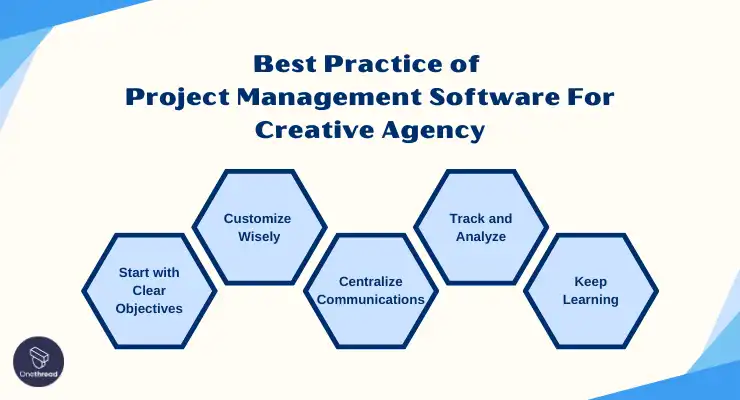
- Start with Clear Objectives: Before diving in, know what you aim to achieve with the software. Whether it’s better task management, invoicing, or team collaboration, clear goals help you make the most of the features.
- Customize Wisely: Tailor the platform to fit your agency’s workflow. Use custom dashboards and tags to keep projects organized and easily accessible.
- Centralize Communications: Use the software’s built-in chat, comment, or email functions to keep all communications in one place. This boosts efficiency and minimizes confusion.
- Track and Analyze: Utilize built-in analytics to track project timelines, team performance, and financials. Make data-driven adjustments for better outcomes.
- Keep Learning: Software updates can bring new features. Stay updated and train your team to utilize the full power of the tool.
By adhering to these best practices, creative agencies can fully leverage project management software for optimal results.
Conclusion
Maximizing the benefits of project management software in a creative agency hinges on clear objectives, smart customization, centralized communication, and data-driven decision-making.
Keeping abreast of updates ensures you’re always using the tool’s full capabilities. By implementing these best practices, you pave the way for streamlined operations, enhanced collaboration, and ultimately, successful project outcomes.
FAQs
How Does Project Management Software Help with Invoicing?
Many platforms include invoicing features or integration with financial software. This allows for seamless tracking of billable hours, generation of invoices, and even payment receipts, all within the same platform.
Are There Any Limitations to Using Project Management Software?
Some common limitations include a steep learning curve for complex platforms, additional costs for premium features, and the potential for feature overload, which can be overwhelming.
Is My Data Secure in Project Management Software?
Security features vary by platform but generally include data encryption, two-factor authentication, and regular backups. Always check the security protocols of the software you’re considering.
